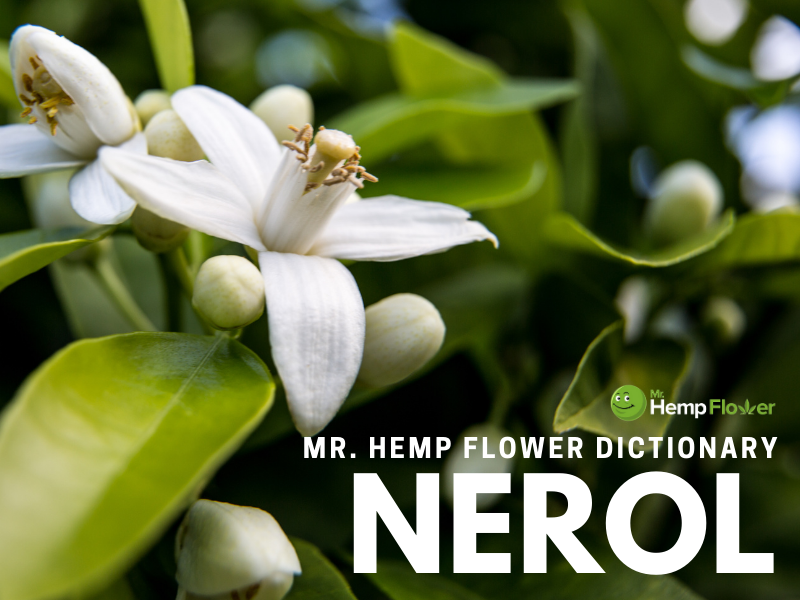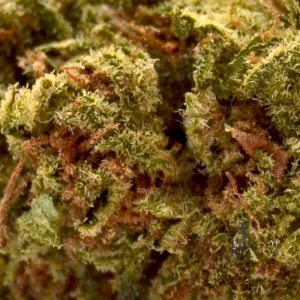Nerol – What Is It? All You Need To Know About Nerol

Nerol
ˈner-ˌȯl, ˈnir- | Noun
A monoterpenoid alcohol found in the essential oils of lemongrass, hops, and catnip. It plays a significant role in the flavor and aroma profiles of rose and palmarosa oils, where it exists in large quantities. Widely used in the fragrances and food industry, this terpene possesses antibacterial and anti-inflammatory properties.
“Did you know that nerol is a terpene found both in hemp and lemongrass?”
“This hemp pre-roll has a fresh-fruit flavor and light rose-like aroma, maybe from the nerol in it.”
What is it?
It’s a hemp terpene that, together with geraniol, is an isomer of citral. This colorless oily fluid was originally isolated from neroli oil — an essential oil produced from the blossom of the bitter orange tree. Compared to geraniol terpene, which has a characteristic sweet, floral, rose-like odor and taste, nerol is sweeter but more subtly scented. This terpene exhibits a fragrant rose and citrus aroma and an enticing flavor of fresh fruit and light floral touches.
Everyday uses of nerol
Because of its rose-like scent, it’s a common ingredient in the fragrance industry. When extracted and isolated, it exhibits a rosy aroma with a hint of citrus. This aroma makes it an excellent addition to scented soaps, lotions, antiperspirants, fabric softeners, and surface disinfectants. Due to its antibacterial nature, this terpene makes a great addition to cosmetic skin treatments, like treatments for acne and minor contusions. Its antimicrobial qualities make it an attractive terpene for aromatherapy or a diffuser.
Aside from its use as a fragrance in cosmetics and personal hygiene products, this terpene is an ingredient in the food industry. Together with other terpenes, it’s used to create artificial flavors like raspberry and apple. Due to its fresh-fruit and light floral aroma, it can be found in citrus-flavored soft drinks.
Therapeutic benefits of this terpene
As a minor terpene found in hemp, it hasn’t been studied as extensively as other terpenes. While it has shown antibacterial, antifungal, and anti-inflammatory properties, further research in humans is needed to verify these benefits.
Antibacterial and antifungal activity
According to studies, this terpene possesses antibacterial properties that make it an excellent addition to topical products that kill bacteria. A 2016 study investigated the antimicrobial effects of this terpene against food-borne bacteria and revealed that it was effective.
Regarding its antifungal effects, one 2010 study looked at lemongrass essential oil, rich in nerol and other terpenes like limonene and geranial. The authors of the study revealed that lemongrass essential oil is a potent inhibitor of C. albicans growth — a pathogenic yeast found in the human gut flora.
Anti-inflammatory effects
Like most terpenes, it acts as a potent anti-inflammatory agent. One 2014 in vitro study examined the anti-inflammatory activity of 20 different essential oils — including lemongrass essential oil that contains a good amount of nerol terpene. The study revealed that this essential oil effectively reduced inflammation and allergic responses to certain allergies.
Another study revealed that nerol possesses anti-inflammatory and pain-blocking properties. Researchers looked at the effects of this terpene in ulcerative colitis and discovered evidence for a beneficial effect of nerol on colitis — suggesting its therapeutic potential for this inflammatory disease.
Where to find it in hemp?
It’s present in trace amounts in some hemp strains or broad spectrum and full spectrum hemp CBD products. You can also find it as a terpene isolate and sprinkle some on your hemp pre-rolls or use it to improve the vaping experience. This terpene is safe and non-toxic to humans, so you can safely eat, drink, and inhale it in the right dosage.
Final thoughts
Nerol is a useful terpene found in hemp and lemongrass essential oil. It exhibits a fresh rose-like floral aroma with a hint of citrus and potent antimicrobial and anti-inflammatory effects.















